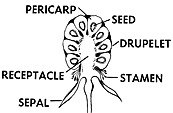Gunpowder Tree
Trema orientalis
Hemp/Hops/Hackberries family (Cannabaceae)
Post-Cook introduction
Medium-sized introduced weedy tree, recognized by the narrowly unequal-sided very long-pointed leaves with finely edges and three main veins from base, spreading in two rows on long slender twigs. To 60 ft (18 ) high and 2 ft (0.6 ) in trunk diameter. Bark light gray grown, smoothish, finely fissured. Inner bark is pink, soft and fibrous, bitter. Twigs long, slender, unbranched, spreading, light green, finely hairy, turning brown.

©2012 Forest And Kim Starr
Flower clusters () at leaf bases, branched, 3⁄8–2 inches (1–5 ) long and broad. Flowers are many, nearly stalkless, light green, 1⁄8 inch (3 ) long, male and female. Female flowers are composed of 5 tiny and with a one-celled and two whitish hairy spreading
() round, nearly 3⁄16 inch (5 ) in diameter, pink to black, fleshy. Seed single, round, brown, more than 1⁄16 inch (1.5 ) long.
Wood pale brown or buff, sapwood not distinct from heartwood. It is lightweight ( gr. 0.40), easy to work, and not resistant to decay or termites (Reyes 1938). The wood has not been used in Hawaii. It is said to make good charcoal for gunpowder, thus the common name.
A weed tree of rapid growth, extending into forest openings in moist lowland areas in Hawaii. It is particularly common in the vicinity of Hilo airport.
Champion
Height 72 ft (21.9 ), c.b.h. 20.5 ft (6.2 ), spread 108 ft (32.9 ). Pepeekeo, Hawaii (1968).
Range
Native from southeastern Asia through Malaysia
Other common names
charcoal tree; banahl (N. Marianas); elodechoel (Palau)
Trema cannabina Lour. (T. amboinensis (Willd.) Blume) is a related native species, a small tree to 30 ft (9 ) high with smaller hairy black about 1⁄8 inch (3 ) long, only slightly fleshy. Elsewhere, a fiber for fish nets has been made from the bark and medicine from other parts. In Hawaii, uncommon in lowland areas, recorded from the five largest islands. Native and more common in other Pacific Islands, such as Samoa, Fiji, and Tahiti, and southeastern Asia to China and India.





